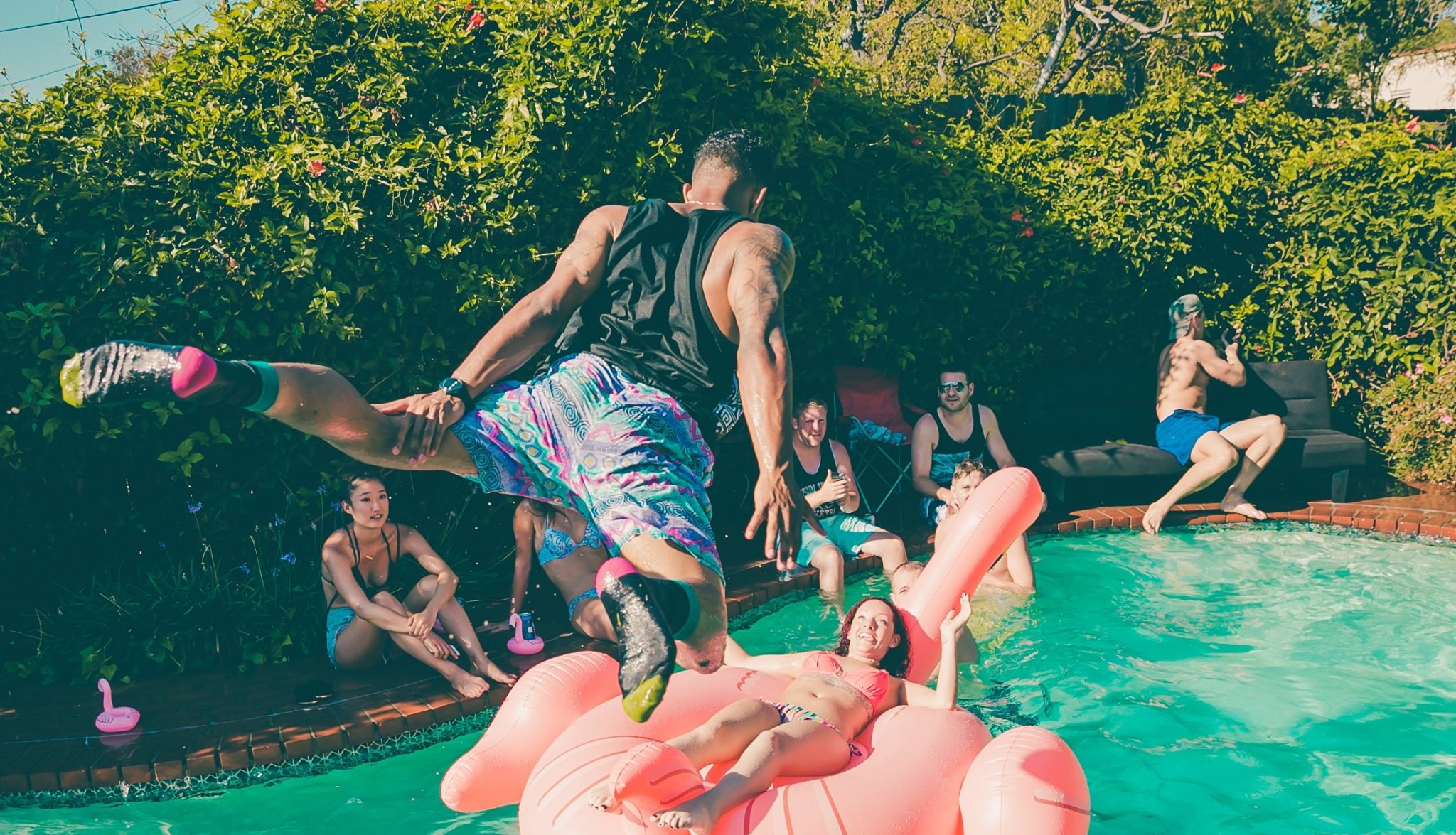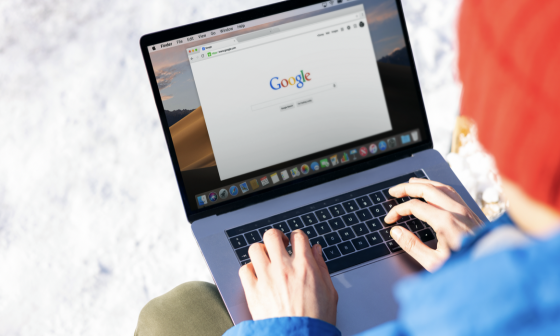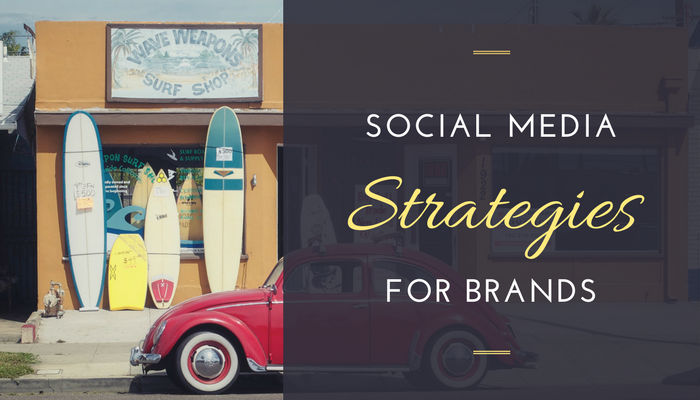1. Coca-Cola’s “Share a Coke” Campaign
Coca-Cola personalized its bottles with popular names, encouraging customers to find bottles with their names and share photos on social media. This campaign significantly increased their consumer engagement and sales and It proved largely successful in Australia and would lead to a broader implementation globally.
➡️“Share A Coke” A Look Back At Coca-Cola’s Iconic Campaign – Here’s more on it.
2. Nike’s “Just Do It” Campaign
Nike’s iconic slogan was revitalized through powerful storytelling and endorsements from prominent athletes, inspiring people to share their own “Just Do It” moments online. It is also remembered as one of the most iconic and successful campaigns to date.
➡️How Nike’s ‘Just Do It’ Campaign Became A Global Phenomenon – World Brand Affairs – Check it out here.
3. ALS Association’s Ice Bucket Challenge
This viral campaign took social media by storm, encouraging participants to pour a bucket of ice water over themselves and nominate others to take on the challenge. Beyond being a fun and engaging trend, it served a bigger purpose, raising awareness about ALS (Amyotrophic Lateral Sclerosis) and generating donations for research. The campaign’s widespread participation, including celebrities, athletes, and public figures, helped it go global, ultimately raising over $115 million for ALS research and making it one of the most successful social media-driven fundraising initiatives of all time.
➡️The ALS Ice Bucket Challenge: How it Started | The ALS Association.
4. Starbucks’ #RedCupContest
Starbucks tapped into the holiday spirit by inviting customers to share photos of their festive red cups on social media. The response was massive, users flooded platforms with their creative shots, leading to a new entry every 14 seconds and an impressive 40,000 submissions in just two days. The campaign not only helped increase their engagement but also turned Starbucks cups into a seasonal tradition, reinforcing brand loyalty and keeping the conversation going well beyond the holidays.
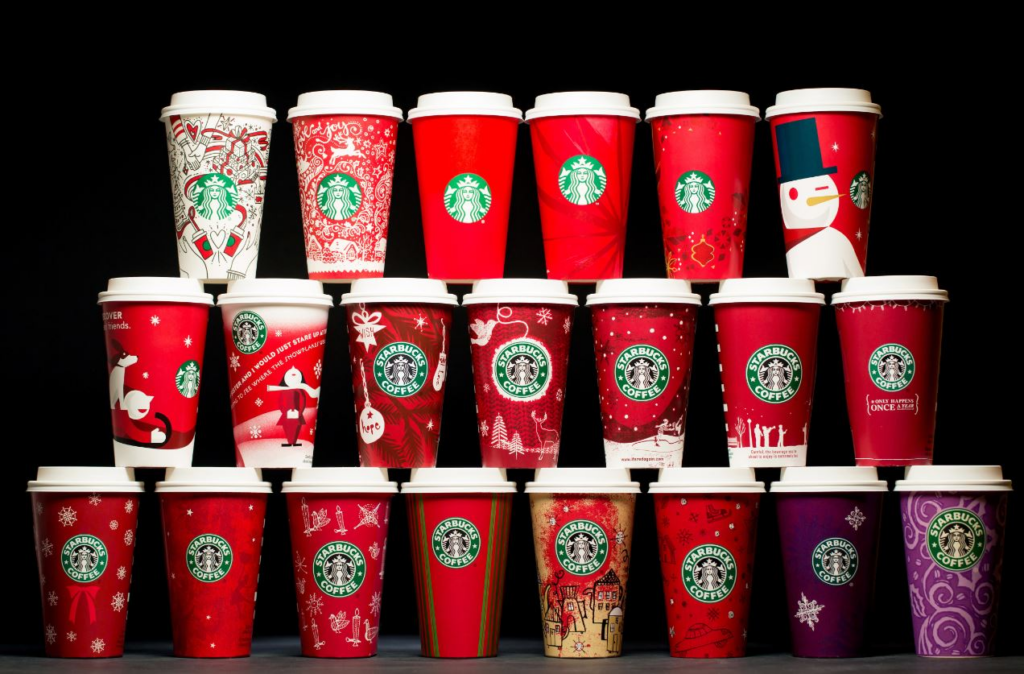
Source: Valens Research
5. Oreo’s “Dunk in the Dark” Tweet
During the unexpected blackout at the 2013 Super Bowl, Oreo seized the moment with a brilliantly timed tweet: “You can still dunk in the dark.” In just a few words, the brand showcased the power of real-time marketing, proving that agility and creativity can make a lasting impact. The tweet instantly went viral, earning thousands of retweets and widespread media coverage, all without a massive ad budget. Oreo’s quick thinking turned a technical mishap into a marketing win, setting a benchmark for brands looking to capitalize on live events with timely and relevant content.
➡️Oreo Super Bowl Blackout Tweet: A Case Study (2024 Edition)
6. Ford’s “Fiesta Movement”
In a bold move to rejuvenate its image and connect with a younger, tech-savvy audience, Ford launched the innovative “Fiesta Movement” campaign in 2009. This initiative saw the company selecting 100 socially influential individuals, referred to as “agents,” from over 4,000 applicants. These agents were entrusted with a Ford Fiesta for six months, during which they documented their experiences across various social media platforms.
The campaign generated significant online buzz, with the agents’ authentic content reaching a wide audience and fostering increased brand awareness and engagement. This approach not only showcased Fiesta’s features through genuine user experiences but also positioned Ford as a forward-thinking brand embracing modern marketing strategies.
➡️Iconic Digital Marketing Case Studies – Part I: The Ford Fiesta Movement
7. Mercedes-Benz’s “Take the Wheel” Campaign
In 2013, Mercedes-Benz sought to captivate a younger, digitally-savvy audience with the launch of their entry-level CLA sedan. To achieve this, they initiated the “Take the Wheel” campaign, collaborating with five prominent Instagram photographers.
Each photographer was provided with a brand-new CLA and embarked on a five-day road trip across the United States, tasked with capturing and sharing six compelling photos daily on both their personal and Mercedes-Benz’s Instagram accounts. The stakes were high: the photographer whose images garnered the most likes would win a three-year lease on the CLA.
This innovative approach not only showcased the vehicle’s appeal through authentic, user-generated content but also significantly amplified the brand’s social media presence. The campaign achieved remarkable results, including over 87 million organic Instagram impressions and more than 2 million likes, effectively redefining Mercedes-Benz’s image and engaging a new generation of potential customers.
➡️Mercedes-Benz Take the Wheel – The Shorty Awards
8. Disney’s “Share Your Ears” Campaign
In a heartwarming initiative to celebrate Mickey Mouse’s 90th anniversary and support the Make-A-Wish Foundation, Disney launched the #ShareYourEars campaign. From November 4 through November 17, 2018, Disney encouraged fans worldwide to post photos of themselves donning Mickey Mouse ears or creatively crafted “ears” on social media platforms like Facebook, Instagram, and Twitter, accompanied by the hashtag #ShareYourEars.
For each public post, Disney pledged to donate $5 to Make-A-Wish, with an initial commitment of up to $1 million. However, due to the overwhelming response, Disney doubled its donation, contributing a total of $2 million to the foundation.
➡️The Walt Disney Company and Make-A-Wish® Invite Fans to “Share Your Ears” to Help Grant Wishes

Source: The Walt Disney Company
The campaign’s success was evident, with over 1.7 million photos shared, resulting in more than 420 million social media impressions. This surge in participation led to a 330% increase in reach and a 554% boost in engagement across Disney’s social media platforms. The initiative not only raised substantial funds for granting wishes to children with critical illnesses but also reinforced Disney’s commitment to philanthropy and community engagement.
Building on this momentum, Disney continued the #ShareYourEars campaign in subsequent years, further solidifying its partnership with Make-A-Wish and its dedication to making a positive impact on children’s lives.
9. Brita’s “Filter Your Feed” Campaign
Brita, best known for its water filtration products, took an unexpected but brilliant turn into social advocacy with its “Filter Your Feed” campaign. Teaming up with NBA superstar Stephen Curry, the brand encouraged people to “filter out the negativity” from their online spaces, just like Brita filters out impurities from water.
The campaign included a mix of humorous yet thought-provoking ads, where Curry directly addressed the importance of curating a positive social media experience. With digital wellness becoming a hot topic, this campaign resonated strongly, driving engagement across multiple platforms.
The Filter Your Feed campaign has garnered 200 million earned media impressions, measured across both social and traditional outlets, with about 61 million impressions coming from social media engagement. The brand’s goal was 70 million.
➡️Brita passes to Steph Curry to filter out cyberbullying | PR Week
10. Rimmel London’s “#IWillNotBeDeleted” Campaign
Beauty brands have long been at the center of conversations around self-esteem, but Rimmel took a bold stance against cyberbullying with its #IWillNotBeDeleted campaign. Featuring celebrities like Rita Ora and Cara Delevingne, the campaign shined a light on the thousands of beauty-related photos deleted daily due to online bullying.
Rimmel invited individuals to share their experiences, sparking an open dialogue about the damaging effects of digital harassment. The campaign struck a chord with Gen Z and Millennials, reinforcing Rimmel’s positioning as a brand that champions confidence and self-expression.
➡️ I Will Not Be Deleted | Cybersmile Campaign
11. Kamala Harris’s Meme-Driven Campaign
During the 2024 U.S. presidential race, Kamala Harris’s campaign team leaned heavily into meme culture to engage younger voters. Instead of sticking to traditional political messaging, they embraced TikTok trends, internet humor, and relatable content to humanize Harris and make her policies more digestible.
By leveraging viral moments and user-generated content, the campaign saw higher engagement rates among voters aged 18-39, proving that digital-first strategies can reshape political outreach.
➡️‘Kamala is BRAT’: How Harris campaign is embracing memes – Times of India
12. Dove’s #TurnYourBack Campaign Against Digital Distortion
Continuing its commitment to authentic beauty representation, Dove launched the #TurnYourBack campaign in 2023 to combat the pervasive issue of digital distortion caused by social media filters. Recognizing the detrimental effects these filters have on self-esteem, especially among young women, Dove encouraged individuals to “turn their backs” on unrealistic beauty standards. The campaign featured powerful visuals and testimonials highlighting the contrast between filtered and unfiltered images, urging users to embrace their natural beauty. By partnering with influencers and leveraging user-generated content, Dove sparked a global conversation about self-acceptance and the importance of presenting one’s true self online. The initiative not only garnered widespread media attention but also reinforced Dove’s brand ethos centered around real beauty and confidence.
➡️Discover more about Dove’s #TurnYourBack campaign here.
13. McDonald’s “Raise Your Arches” Campaign
In a playful nod to its iconic golden arches, McDonald’s unveiled the “Raise Your Arches” campaign in 2023. The initiative featured a series of advertisements depicting people from diverse backgrounds raising their eyebrows, a gesture mimicking the McDonald’s arches in anticipation of enjoying a meal from the fast-food giant. This simple yet effective concept resonated with audiences globally, leading to a surge in user-generated content where fans shared their own “raised arches” moments on platforms like TikTok and Instagram. The campaign’s relatable and lighthearted approach not only bolstered brand engagement but also showcased McDonald’s ability to connect with consumers through universal expressions of excitement and joy.
➡️Read it here: Raise Your Arches
14. Heinz and Absolut Vodka’s “Heinz Absolutely” Collaboration
In an unexpected yet delightful partnership, Heinz teamed up with Absolut Vodka in February 2023 to introduce the “Heinz Absolutely” campaign. This collaboration resulted in a limited-edition tomato vodka pasta sauce, blending Heinz’s rich tomato heritage with Absolut’s premium vodka. The campaign featured engaging content across social media platforms, including recipe tutorials, behind-the-scenes glimpses into the sauce’s creation, and interactive contests encouraging fans to showcase their culinary creations using the unique sauce. This innovative fusion not only intrigued food enthusiasts but also highlighted the potential of cross-brand collaborations in creating buzzworthy products that captivate diverse audiences.
➡️Absolutely Heinz: A Collaboration That Took Over Social Media | EBC: Ewha [Brand Communication]
15. Semrush’s “Chris” Character Series
In a bid to engage digital marketers with relatable and entertaining content, Semrush introduced a character named “Chris” in 2023. This series of videos featured Chris navigating various challenges and scenarios familiar to marketing professionals, presented with a humorous twist. The content struck a chord within the marketing community, leading to significant engagement across platforms like TikTok, where the top-performing video amassed over 150,000 likes. By personifying common industry experiences through Chris, Semrush not only provided value-driven content but also fostered a sense of community among digital marketers, enhancing brand loyalty and recognition.
➡️Here’s more on it: 14 Best Social Media Campaigns to Inspire You in 2025
16. Spotify Wrapped
Every December, Spotify Wrapped drops, and like clockwork, the internet explodes. It’s not just a personalized year-in-review; it’s a full-blown cultural moment.
Spotify turns your listening data into colorful, bite-sized slides, highlighting your most-played songs, top artists, favorite genres, and even new additions like your “Listening Personality.” But the real magic? Wrapped is built for sharing.
The slick, Instagram-ready graphics make it way too easy for users to flex their music taste across social media. And just like that, millions of people are giving Spotify free marketing.
Spotify keeps evolving Wrapped to stay fresh. They’ve added podcast highlights, global listening trends, and interactive quizzes, making sure there’s something for every type of listener. And every year, the FOMO grows, and people who don’t have Spotify suddenly feel like they’re missing out, leading to a surge in sign-ups.
Other brands have tried to copy the Wrapped formula, but none have cracked the code quite like Spotify. It’s not just a campaign, it’s a tradition, a flex, and one of the smartest marketing moves in recent years.
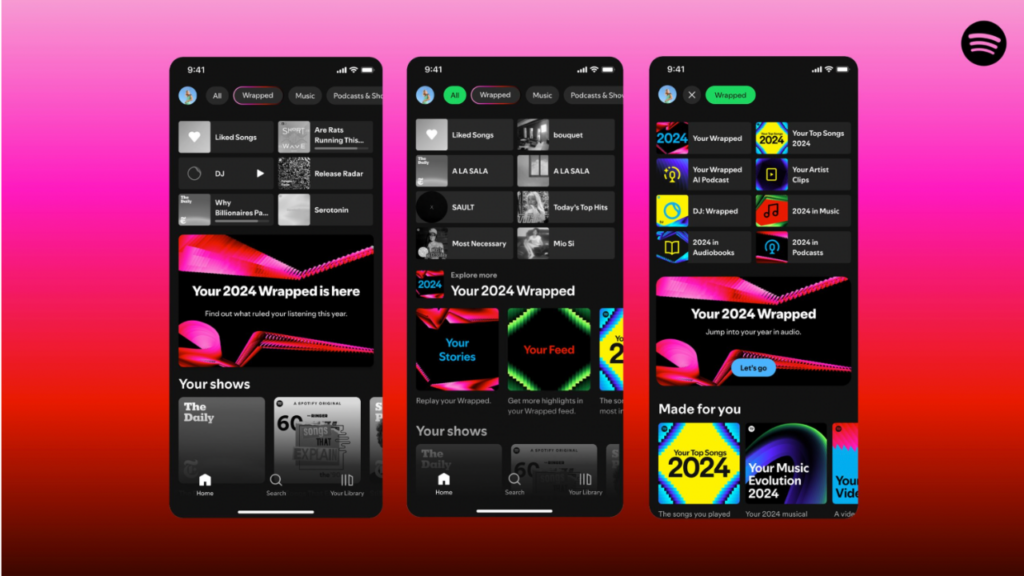
Read more: Four Reasons Why Spotify Wrapped is Marketing Genius
17. Heinz and Seemingly Ranch
Heinz pulled off a masterclass in real-time marketing with its Seemingly Ranch campaign, proving that the right mix of speed, cultural relevance, and exclusivity can drive massive brand engagement.
It all started with a simple viral moment, Taylor Swift was spotted at a Kansas City Chiefs game, eating chicken with “ketchup and seemingly ranch” (as described in a fan’s tweet). That phrase took off, spreading across social media like wildfire. Heinz wasted no time, jumping on the trend by announcing a limited-edition “Seemingly Ranch” sauce, a blend of ketchup and ranch.
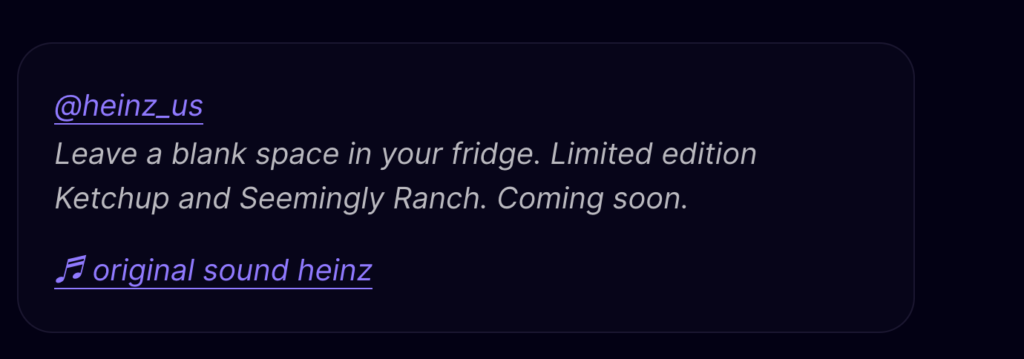
Why This Worked So Well:
- They moved fast: Speed is everything in reactive marketing, and Heinz didn’t sit on this. They turned a viral tweet into an actual product within days.
- They tapped into a massive cultural moment: Taylor Swift + the NFL was already dominating headlines, so Heinz piggybacked on an existing wave of attention.
- Scarcity created demand: Only 100 bottles were made, making it feel exclusive and driving even more hype.
- It was organic and effortless: This didn’t feel forced. It wasn’t a hard sell, it was just Heinz having fun with the internet, and people loved it.
- Earned media did the work: Between social media buzz and media outlets picking up the story, Heinz got a ton of free exposure without pouring millions into ads.
18. Expedia’s “Let’s Take a Trip” campaign
Expedia took a creative approach during the pandemic with its ad Let’s Take a Trip, tapping into the collective longing for travel while keeping the brand top of mind.
Expedia – Let’s take a trip Stop-Motion (Team One, 2020)
The stop-motion film, directed by Victor Haegelin and developed with TeamOne, shows a couple recreating holiday experiences at home using everyday items, turning sheets into waves, cushions into mountains, and books into roadways.
It perfectly captures the moment, blending humor and creativity with a hopeful message: “Imagine the places we’ll go. Together.” With nearly 20 million YouTube views, the campaign struck the right balance between nostalgia and optimism, reminding people that when travel returns, Expedia will be ready.
19. Apple “Shot on iPhone” Campaign
In 2015, Apple introduced the #ShotOniPhone campaign, encouraging users to showcase their photography skills using iPhones. This initiative has amassed over 17 million posts on Instagram, with Apple’s account dedicated to featuring this user-generated content. In response to the COVID-19 lockdowns in April 2020, Apple adapted the campaign by launching #TheAtHomeSeries, inviting iPhone users to capture and share their unique home experiences.
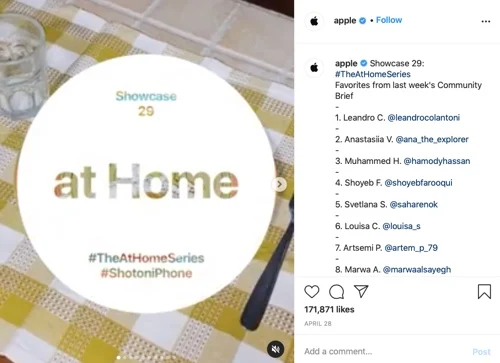
➡️ Here’s everything you need to know about the campaign: Share your best iPhone macro photos for Apple’s Shot on iPhone Challenge – Apple (IN)
20. Instagram’s #ShareBlackStories
Following the protests over George Floyd’s death, Instagram head Adam Mosseri addressed the need for change, tweeting a message of solidarity and responsibility. The platform expanded its #ShareBlackStories initiative, originally launched for Black History Month, by spotlighting Black creators like Rachel Cargle, Texas Isaiah, Ashton Attz, Chef Paola Velez, Antonio Moore, and Shireen. Through weekly features, Instagram used its reach to amplify Black voices and push for meaningful conversations.

21. Wendy’s Savage Twitter Roasts
Wendy’s threw the corporate playbook out the window and embraced a bold, snarky personality on Twitter, clapping back at competitors and roasting customers (in a playful way). This wasn’t just social media banter, it was a strategic move that set the brand apart from the usual, predictable fast-food marketing.
Instead of the usual promos and ads, Wendy’s built a personality that people wanted to engage with. The result? Viral moments, skyrocketing engagement, and a loyal following that actively looks forward to their witty responses. It also created a blueprint for brands looking to connect with younger audiences in a more relatable, unfiltered way.
22. Airbnb’s “We Are Here” Campaign
Airbnb went beyond just showcasing accommodations, they turned travel experiences into real-time entertainment. The “We Are Here” campaign live-streamed unique experiences hosted by Airbnb hosts, from cooking pasta in Italy to flamenco dancing in Spain. Instead of just seeing photos of a listing, audiences got a front-row seat to what it’s like to stay at an Airbnb and truly immerse themselves in local culture.
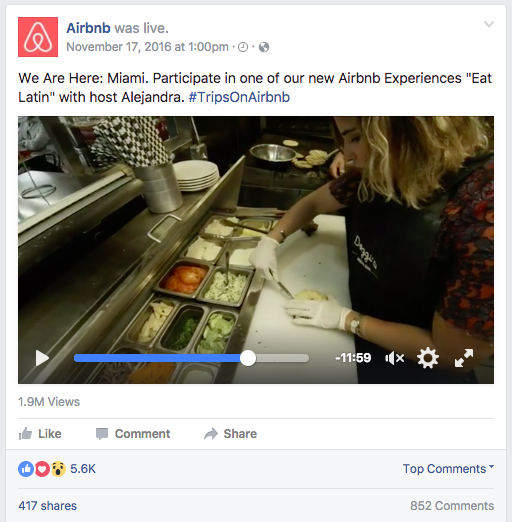
This campaign brilliantly positioned Airbnb as more than just a booking platform, it became a gateway to authentic, one-of-a-kind travel experiences that no hotel chain could replicate.
➡️Read more about it here – Airbnb-We Are Here – Sophie’s Blog
23. Nike’s “You Can’t Stop Us” Campaign
Nike has always nailed the art of emotional storytelling, and “You Can’t Stop Us” was no exception. This split-screen ad seamlessly merged footage of athletes from different sports and backgrounds, showcasing themes of unity, resilience, and perseverance. The editing alone was mind-blowing, but what really made this campaign powerful was its message: no matter the challenges, the human spirit is unstoppable.
Nike – You Can’t Stop Us (2020)– Here’s the full video that sparked the buzz!
It was shared millions of times, sparked conversations, and solidified Nike’s reputation for blending purpose with marketing. At a time when the world needed motivation, Nike delivered.
24. Always’ #LikeAGirl
The phrase “like a girl” has been used as an insult for years, and Always decided it was time to change that. The #LikeAGirl campaign showed young girls confidently running, throwing, and fighting, challenging outdated stereotypes and reshaping how people interpret the phrase. It wasn’t just an ad; it sparked a global conversation about gender perception and self-esteem. With millions of views and a massive shift in brand perception, this campaign proved that purpose-driven marketing can resonate deeply and make a real impact while keeping a brand top-of-mind.

➡️Case study: Always #LikeAGirl
25. Zoom’s Virtual Background Contest
During the remote work boom, Zoom found a fun way to keep users engaged: a virtual background contest. This simple yet brilliant move encouraged users to create and share their most creative backgrounds, adding a layer of personality and entertainment to the endless video calls. It turned Zoom meetings from mundane to amusing and gave the brand an interactive way to stay relevant. More than just a marketing gimmick, it strengthened the sense of community among users and showcased Zoom as a platform that understood the moment and adapted accordingly.

➡️The Best Social Media Campaigns of 2020
26. DNC’s Influencer Collaboration
The Democratic National Committee took a fresh approach to political outreach by credentialing over 200 content creators to cover their convention, treating them like traditional media. This wasn’t just about reaching more people, it was about meeting younger voters where they already are: social media.
By leveraging influencer-driven content, the DNC significantly expanded its reach and engagement, with over 350 million views on partner-created content. This move showed that the power of political messaging no longer lies solely in traditional news but in relatable, authentic content from influencers who resonate with younger audiences.
➡️Read everything about it here: https://demconvention.com/news/news/democratic-national-convention-eclipses-maga-convention-viewership-across-broadcast-streaming-and-online-platforms
27. NASA’s ‘Send Your Name to Mars’

Source: NASA
NASA found a genius way to make space exploration feel personal. Instead of just broadcasting another Mars mission, they invited the public to submit their names to be sent aboard the Mars rover. It was a simple yet effective way to get people excited about space travel and foster a sense of participation. Millions signed up, making the campaign a massive success. It wasn’t just about names on a microchip—it was about giving everyday people a small stake in something as grand as interplanetary exploration.
28. Run for Heroes’ #Run5Donate5Nominate5 Campaign
Sometimes, the most impactful campaigns don’t come from big-budget marketing teams, they start at the grassroots level and take on a life of their own. That’s exactly what happened with the Run 5, Donate 5, Nominate 5 challenge, a simple yet powerful initiative that encouraged people to run 5 kilometers, donate £5 to NHS Charities Together, and tag five others to keep the momentum going.
It kicked off as a small community-driven effort but quickly turned into a nationwide movement, thanks to its easy participation model and a cause that resonated with everyone. Social media played a huge role, people shared sweaty post-run selfies, added personal messages of support, and kept the nominations rolling. Before long, celebrities, athletes, and influencers jumped in, further amplifying its reach.
The result? Over £7 million raised for NHS Charities Together, proving that when you combine a meaningful cause with a format that’s fun and easy to share, digital virality can translate into real-world impact.
29. Democratic National Committee’s Influencer Collaboration
For the first time, the Democratic National Convention (DNC) shook things up by officially credentialing over 200 content creators, giving them the same level of access as traditional media. This wasn’t just a nod to the changing media landscape, it was a strategic move to tap into younger audiences who are more likely to get their news from TikTok and Instagram than from cable news.
By bringing in influencers, independent journalists, and digital storytellers, the DNC ensured that key moments from the convention reached people where they already spend their time on social media. These creators didn’t just report; they engaged, broke down policy discussions into digestible content, and gave their followers a front-row seat to the political process.
This resulted in a staggering 350 million views on partner-created content, proving that if you want to engage Gen Z and millennials, you need to meet them where they are.
➡️With the DNC, Democrats finally understand that content is king
30. #TeamTrees Initiative
What happens when you mix internet culture with a mission-driven cause? You get #TeamTrees, one of the most successful digital activism campaigns to date. Spearheaded by YouTuber MrBeast and the Arbor Day Foundation, the initiative set out with an ambitious goal: plant 20 million trees. And thanks to the power of the internet, it didn’t just gain traction, it exploded.
Influencers, brands, and everyday people rallied behind the cause, using their platforms to spread the message and drive donations. Elon Musk, Shopify’s CEO, and even YouTube itself jumped in, helping the campaign hit its target ahead of schedule. What made #TeamTrees so effective wasn’t just the cause, it was how seamlessly it fit into online culture. The messaging was simple, the ask was clear, and the internet loves a big, collective challenge. In the end, it raised millions and proved that when online communities come together, they can drive real-world impact at an insane scale.
➡️#TeamTrees: YouTube stars boost tree-planting campaign to over $8m
31. #ChallengeAccepted
This global movement saw women sharing black-and-white selfies to promote female empowerment and solidarity. What started as a simple challenge quickly turned into a movement, fostering conversations about strength, resilience, and women supporting women.
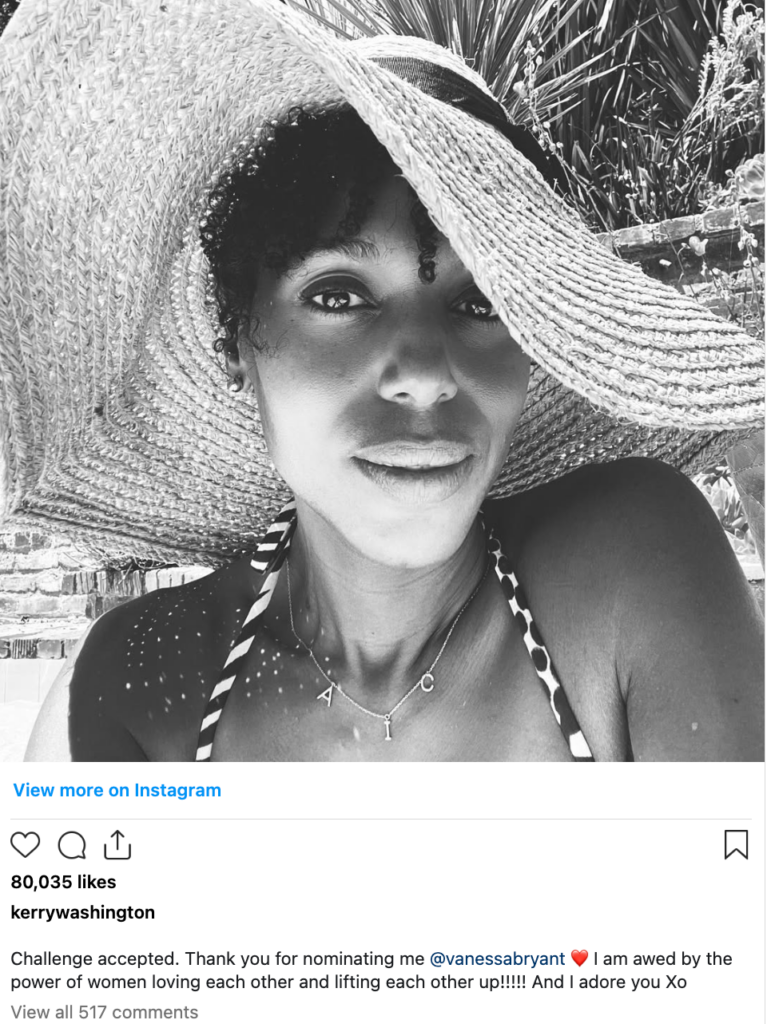
Source: New York Times
The simplicity of the challenge made it accessible, and its underlying message gave it staying power, making it one of the most widely shared social campaigns of the time.
➡️‘Challenge Accepted’ on Instagram: Black and White Selfies for Women – The New York Times
32. #MetGalaChallenge
When the Met Gala got postponed, Vogue didn’t just sit back and wait—they turned the situation into a viral moment. Enter the #MetGalaChallenge, a genius way to keep the fashion conversation alive while tapping into the creativity of everyday people. The challenge was simple: recreate iconic Met Gala looks using whatever you had at home. No designer gowns? No problem. People got resourceful, bedsheets turned into couture, trash bags became high fashion, and the results were equal parts hilarious, impressive, and wildly entertaining.
What made this campaign a hit was its accessibility. Unlike the actual Met Gala, which is exclusive to A-list celebrities, #MetGalaChallenge was open to everyone, making it the most inclusive fashion event of the year. Celebrities like Billy Porter and the legendary Anna Wintour even joined in, amplifying the challenge’s reach. The campaign didn’t just keep Vogue’s audience engaged, it proved that creativity thrives under constraints and that digital participation can make even the most exclusive events feel communal.
➡️https://www.artandobject.com/news/met-gala-challenge-brings-high-fashion-home
33. #PassTheBrush Challenge
The beauty community found a fun, collaborative way to engage during lockdown with the #PassTheBrush challenge. Participants started bare-faced, then “passed” a makeup brush off-screen, revealing a fully glammed-up transformation. The chain effect made it feel like a collective experience, showcasing creativity while keeping audiences entertained. It was proof that even in challenging times, creativity finds a way to shine.
34. Heineken’s #BackTheBars Campaign
When bars and pubs took a massive hit during lockdowns, Heineken didn’t just sit on the sidelines, they stepped in with #BackTheBars, a campaign designed to support the struggling hospitality industry while keeping their brand firmly in the conversation. The idea was simple but effective: encourage consumers to purchase beer vouchers that could be redeemed once bars and pubs reopened. This provided much-needed immediate financial relief to local establishments while giving people something to look forward to when restrictions lifted.
What made #BackTheBars stand out was how seamlessly it blended corporate social responsibility with brand loyalty. Heineken wasn’t just throwing money at the problem, they were actively mobilizing their customers to take part in the solution. By reinforcing their deep-rooted connection to bar culture, they ensured that when doors finally reopened, Heineken would be the beer people raised their glasses to. The campaign was a win-win: bars got the support they desperately needed, and Heineken strengthened its brand affinity in a way that felt authentic and impactful.
➡️Back to the Bars, latest edition of #SocialiseResponsibly
35. #StopHateForProfit Campaign

As concerns over hate speech and misinformation on social media reached a tipping point, the #StopHateForProfit campaign emerged as a bold call to action. Organizations and activists urged businesses to pause their ad spending on platforms that weren’t doing enough to combat harmful content putting the pressure directly on social media giants like Facebook.
This wasn’t just a statement, it was a movement backed by some of the biggest names in the business. Brands like Coca-Cola, Unilever, and Patagonia pulled their ads, making it clear that if platforms didn’t take real steps toward change, they’d lose millions in revenue. The campaign sparked widespread debate on corporate responsibility in digital advertising, forcing tech companies to publicly reassess their policies on hate speech and misinformation. It was a defining moment that proved brands can (and should) take a stand on social issues and that when they do, they have the power to drive real change.
➡️#StopHateForProfit – The Shorty Awards
36. #InMyScrubs Campaign

Source: QSR Magazine
At the peak of the COVID-19 pandemic, while the world stayed home, healthcare workers stepped up, and social media became a platform to recognize their sacrifice. The #InMyScrubs movement saw doctors, nurses, and frontline medical professionals sharing photos of themselves in scrubs, putting a human face to the crisis. In a time when PPE and face masks made healthcare workers almost unrecognizable, this campaign reminded people that behind every mask was a real person, exhausted yet committed to saving lives.
What started as a grassroots initiative quickly gained momentum, fostering public appreciation for the medical community and countering misinformation about the healthcare industry. It wasn’t just a hashtag. it became a symbol of resilience, dedication, and unity. People rallied behind it, sharing messages of gratitude, donating supplies, and using social media to amplify the voices of those on the frontlines. In a world filled with uncertainty, #InMyScrubs was a powerful reminder of the heroes who showed up every single day.
➡️#InMyScrubs Campaign Unites Healthcare Workers – QSR Magazine
37. #ClapForOurCarers
Sometimes, the simplest gestures make the biggest impact. #ClapForOurCarers started as a small initiative in the UK, encouraging people to step outside their homes at a scheduled time to applaud healthcare and essential workers. What no one expected was just how quickly it would turn into a global movement.
Videos flooded social media as entire neighborhoods, city blocks, and even national landmarks joined in. From apartment balconies in London to the streets of New York, people clapped, banged pots, and cheered to show gratitude for those on the frontlines of the pandemic. It wasn’t just about the applause, it was about unity. In a time when isolation was at an all-time high, this movement created a shared moment of appreciation, reminding everyone that even while apart, we were still in this together. #ClapForOurCarers became more than just a viral trend, it was a symbol of resilience, gratitude, and the power of collective support in a time of crisis.
➡️Clap For Our Carers Campaign | Compass Fostering
38. Ocean Spray’s ‘Dreams Challenge
When a TikTok user casually filmed himself skateboarding while sipping Ocean Spray cranberry juice to the tune of Fleetwood Mac’s Dreams, no one could have predicted the viral storm that followed.

Source: Business Insider
Ocean Spray smartly jumped on the trend, gifting the creator a truck full of their product and joining the online conversation. The result? A massive surge in brand awareness and sales, all from a user-generated moment that perfectly captured a laid-back, feel-good vibe.
39. Severance Pop-Up Stunt
To build anticipation for the new season of Severance, the show’s marketing team didn’t just drop a trailer and call it a day, they went full-on immersive. They recreated the eerie, minimalist office environment from the series as a real-world pop-up experience, allowing fans to step inside and live the unsettling world of Lumon Industries firsthand.
The activation nailed every detail, from the sterile, fluorescent-lit workspace to the cryptic corporate messaging, making visitors feel like they had actually undergone the “severance” procedure. Attendees documented their experience, flooding social media with posts, TikToks, and reaction videos, which only added to the show’s mystique.

Source: Mashable
What made this campaign brilliant was how it blurred the lines between fiction and reality, pulling fans deeper into the show’s unsettling universe. It wasn’t just a marketing stunt, it was an experience, one that turned attendees into brand ambassadors, sparked online conversations, and proved that when experiential marketing is done right, it can drive massive engagement both offline and on social media.
➡️Read everything about it here: I Went To The Severance Pop-up In Grand Central Station. It Was Wild. – TV Shows
40. Trump’s McDonald’s Stunt
Donald Trump has always understood the power of a well-timed media moment, and his surprise visit to a McDonald’s was no exception. Playing right into his populist brand, he casually walked behind the counter, grabbed a serving tray, and started handing out fries to customers, while the cameras, of course, captured every second.
The stunt went viral almost instantly. Supporters saw it as proof that he’s in touch with everyday Americans, while critics debated whether it was just another calculated PR move. Either way, it dominated news cycles, sparked endless online discussions, and reinforced his ability to command attention with even the simplest gestures.
Trump has always had a knack for turning everyday moments into headline-making events, and this was yet another masterclass in media manipulation. Love him or hate him, he knows how to keep people talking and in the world of modern politics, that’s half the battle.

41. CRED’s ‘Fills Most Voids’ Campaign
CRED has built a reputation for advertising that doesn’t just sell—it entertains. With the Fills Most Voids campaign, they took this approach to the next level, using humor and absurdity to show how their app adds unexpected value to users’ lives.
The campaign featured exaggerated, tongue-in-cheek scenarios where CRED quite literally “filled” different kinds of voids, whether it was an emotional gap, an awkward silence, or even a physical empty space. The writing was sharp, the visuals were quirky, and the message was clear: CRED isn’t just about managing credit cards; it’s about making life unexpectedly better.
What made this campaign shine was how effortlessly it fit into CRED’s signature offbeat style. Instead of a straightforward product pitch, they created something people actually wanted to watch and share. It wasn’t just another fintech ad, it was pure entertainment wrapped in a marketing masterstroke, proving yet again that CRED knows exactly how to make finance fun.
Fills most voids ft. Zeenat Aman | CRED
42. Duolingo’s ‘Adoption Center’ Campaign
Duolingo has always understood that learning a language needs to feel fun, not like a chore. With its Adoption Center campaign, the brand leaned into its signature playful marketing by personifying language courses as characters waiting to be ‘adopted.’
The concept was simple but brilliant, each language had its own personality, quirks, and charm, making users feel like they were picking a lifelong companion rather than just selecting a course. This emotional hook made committing to a new language feel like a personal journey rather than just another feature in an app.
Beyond the creativity, the campaign tapped into gamification, a key part of Duolingo’s success. By making the choice feel engaging and rewarding, the brand reinforced why it continues to stand out in the crowded edtech space. Whether it was the charm of the campaign or the guilt-inducing push notifications from Duo the Owl, one thing was clear, Duolingo knows exactly how to keep users hooked.
43. GoPro’s ‘Awards’ Campaign
GoPro has always thrived on its community, and the GoPro Awards campaign is a masterclass in how to turn users into brand ambassadors. Instead of traditional ads, GoPro encouraged users to submit their best GoPro-captured footage for a chance to win prizes and be featured on the brand’s social media platforms.
The result? A never-ending stream of jaw-dropping, high-adrenaline content, stunning landscapes, extreme sports, and once-in-a-lifetime moments all captured by real people using GoPro products. This reinforced the brand’s reputation as the go-to camera for adventure seekers and gave users a sense of ownership in the GoPro story.
By turning its audience into content creators, GoPro effectively made its marketing feel organic, aspirational, and community-driven. The campaign proved that the best way to showcase a product’s capabilities isn’t through scripted ads, it’s by letting real users do the talking (or in this case, the filming).
➡️GoPro Awards: Official Selections – YouTube
44. CoorDown’s ‘#AssumeThatICan’ Campaign
For World Down Syndrome Day 2024, CoorDown didn’t just raise awareness, it challenged deeply ingrained biases with its powerful #AssumeThatICan campaign. The initiative took aim at the limiting assumptions society places on individuals with Down syndrome, flipping the narrative to highlight their capabilities, independence, and right to be seen beyond stereotypes.
At the heart of the campaign was an emotionally charged video featuring real people with Down syndrome confronting the expectations placed on them. Instead of being defined by what they can’t do, they showcased what they can, whether it was pursuing careers, excelling in sports, or leading fulfilling lives on their own terms.
What made #AssumeThatICan so impactful wasn’t just its message but its execution. The storytelling was raw, the visuals were compelling, and the takeaway was clear: it’s time to shift the way society views disability. The campaign sparked global conversations around empowerment and inclusion, proving that the best advocacy isn’t just about visibility it’s about changing perceptions.
➡️CoorDown: Assume That I Can • Ads of the World™ | Part of The Clio Network
45. Pepsi’s ‘Pilk’ Campaign
Pepsi knows how to spark a conversation, and the Pilk campaign was a prime example of turning curiosity into viral engagement. The idea? A simple yet unexpected mix, Pepsi and milk. While it might have sounded bizarre to some, that was exactly the point.
Leaning into internet culture, Pepsi encouraged users to try Pilk for themselves and share their reactions online. Social media exploded with people either raving about the creamy, soda-float-like taste or cringing at the very thought of it. Celebrities and influencers jumped on board, fueling the debate and making Pilk one of the most talked-about drink trends of the moment.
But this wasn’t just a quirky stunt, it was a strategic move to position Pepsi as a brand that embraces playful experimentation. Love it or hate it, people were talking, and that’s what great marketing is all about. Pepsi once again proved that sometimes, the best way to win attention isn’t by playing it safe, it’s by getting people to take a sip and decide for themselves.
➡️https://abc7.com/what-is-pilk-pepsi-milk-and/12516046/

46. Coca-Cola’s ‘Taste the Future’ AI-Powered Campaign
Coca-Cola took AI-driven marketing to a whole new level with a campaign that turned consumers into co-creators. Instead of just watching an ad, participants got to be the ad.
Here’s how it worked: users answered a series of fun, personality-based questions—think favorite flavors, vibe preferences, and aesthetic choices. Then, using AI, Coca-Cola generated a fully personalized commercial tailored to each individual’s tastes. The result? A one-of-a-kind ad experience that felt less like marketing and more like digital magic.
The impact was massive. Engagement shot up by 45%, proving that AI-powered personalization isn’t just a gimmick. More importantly, Coca-Cola managed to make AI feel approachable and exciting rather than overwhelming. In an era where brands are still figuring out how to introduce AI to their audiences, Coca-Cola nailed the balance between innovation and human connection.
This campaign wasn’t just about selling soda. It was about setting the standard for how brands can use AI to create immersive, memorable experiences.
➡️Coca-Cola: The future is ‘AI meets human ingenuity’
47. Fashion Nova’s Social Media Engagement
Fashion Nova has mastered the art of staying relevant, and 2024 was no different. Their strategy? A relentless mix of consistency and influencer marketing that ensured their brand was everywhere, all the time.
From micro-influencers to A-list celebrities, Fashion Nova’s clothing was in constant circulation on social media. They didn’t just follow trends, they created them. Whether it was a viral outfit challenge, a celebrity collab, or a rapid response to the latest fashion craze, Fashion Nova was always in the mix.
The key to their success? Speed + audience-driven content. They listened, adapted, and delivered exactly what their customers wanted, sometimes before they even knew they wanted it. The result? Non-stop engagement, millions of impressions, and a brand presence that simply couldn’t be ignored.
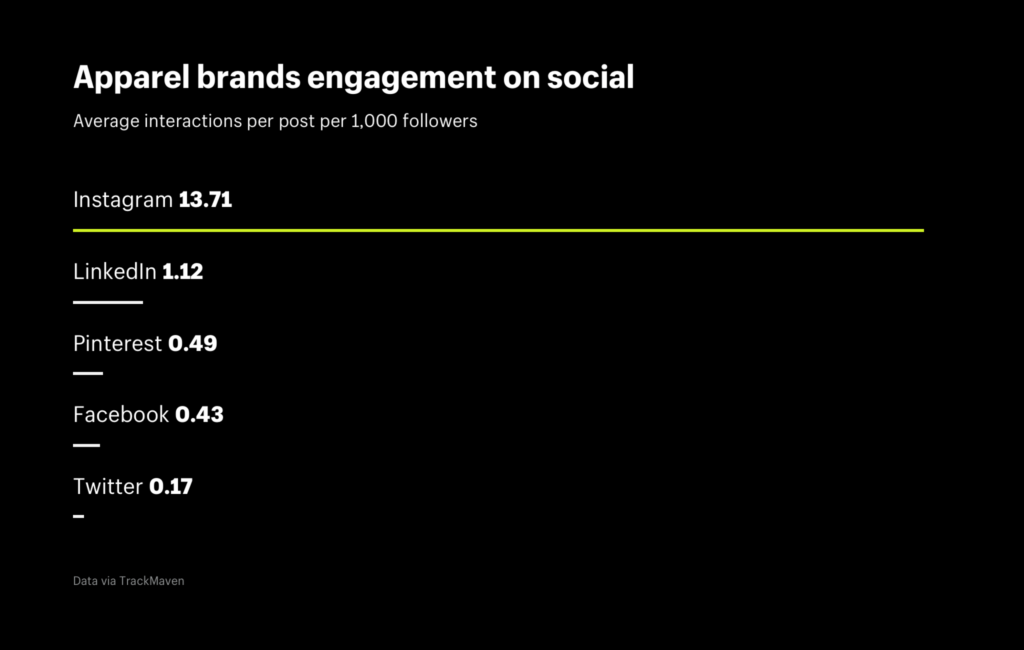
48. Adidas’ Influencer-Driven Campaigns
Nike might dominate sports marketing, but Adidas is playing the long game and winning. Their 2024 strategy was all about consistency and influence, proving that a well-executed influencer approach can build a fiercely loyal fanbase.
By tapping into both athletes and social media creators, Adidas found the sweet spot between performance-driven storytelling and streetwear culture. Whether it was a high-energy campaign featuring elite athletes or a sneaker drop fueled by fashion influencers, the brand made sure its message resonated with the right audience at the right time.
Beyond just hype, Adidas also leaned into sustainability initiatives, ensuring they weren’t just part of the cultural conversation but leading it. The result? A brand that stays relevant across multiple demographics, without trying too hard.

Source: Ad Mazad
➡️Adidas’ Influencer Campaign| AdMazad
49. Rihanna’s Fenty Hair Launch
Rihanna knows how to build a brand, and Fenty Hair was no exception. When she announced her latest beauty venture in 2024, she did it the Rihanna way, with hype, exclusivity, and a perfectly executed social media rollout.
From the moment the teaser dropped, fans were hooked. The campaign leaned into high-fashion visuals, influencer collaborations, and Rihanna’s undeniable star power to create instant buzz. She didn’t just sell haircare she sold an experience, positioning Fenty Hair as the go-to brand for all hair types, textures, and styles.

Source: Retail Drive
What made this launch so powerful was how effortlessly it fit into the Fenty empire. Just like her beauty and lingerie lines, Fenty Hair pushed inclusivity, innovation, and bold self-expression, making it more than just another celebrity brand, it was a cultural moment. The internet took care of the rest, proving once again that when Rihanna speaks, the world listens.
➡️https://www.retaildive.com/news/rihanna-launches-fenty-hair/718970/
50. Tirtir’s Exponential Growth
TIRTIR might not have been a household name a few years ago, but in 2024, the Korean beauty brand skyrocketed to global fame, thanks to strategic influencer marketing, viral TikTok moments, and a community-driven approach.
The turning point? Their Mask Fit Red Cushion foundation. The product exploded on social media, with beauty influencers and everyday users raving about its flawless, long-lasting finish. TikTok reviews, before-and-after videos, and comparison tests flooded feeds, making it the latest must-have in the beauty world.
But TIRTIR didn’t just rely on virality, it leveraged the momentum. They tapped into beauty influencers across different regions, collaborated with K-pop idols, and ensured that their product was easily available for international buyers. The result? A brand that went from niche to mainstream almost overnight, proving that in the age of social media, the right product and the right strategy can turn a brand into a global sensation.

51. Gamer Supps’ YouTube Success
Gamer Supps, an energy drink company tailored for gamers, has achieved remarkable success on YouTube by cultivating a dedicated influencer network. In 2024, the brand stood out among media platforms like Spotify, Apple Music, Netflix, and HBO Max, largely due to unwavering support from loyal influencers.
A significant factor in Gamer Supps’ growth is its ownership by popular YouTube content creator and Twitch streamer, Johnathan Schlatt, known online as jschlatt. His influence and understanding of the gaming community have been instrumental in aligning the brand with its target audience.
Financially, Gamer Supps reported online sales revenue of $2,137,470 in December 2024, with a conversion rate between 2.00-2.50% and an average order value ranging from $50 to $75. This performance underscores the effectiveness of their influencer-driven marketing strategy.
By leveraging the reach and credibility of gaming influencers, Gamer Supps has successfully positioned itself as a preferred energy drink within the gaming community, demonstrating the power of targeted influencer marketing in the digital age.
➡️Read everything about it here: Who Owns Gamer Supps – 24/7 Wall St.
52. Spotify’s Influencer Collaborations
Spotify has mastered influencer marketing, seamlessly integrating creators into its campaigns to keep the brand top of mind. In 2024, they doubled down on partnerships with YouTubers, TikTokers, and podcasters, making sure their messaging felt less like an ad and more like an organic recommendation.
One of their biggest moves? Collaborating with top creators to curate exclusive playlists and behind-the-scenes content. By giving influencers their own space on the platform, Spotify turned them into ambassadors who naturally promoted the app to their audiences. This strategy boosted engagement and reinforced Spotify as the go-to streaming service across different demographics.
The results speak for themselves: Spotify saw a surge in user-generated content, with influencers casually incorporating the brand into their daily lives rather than pushing hard sells. It’s a perfect example of how influencer marketing, when done right, doesn’t feel forced—it just fits.
➡️https://neoreach.com/spotify-influencer-marketing/
Wrapping up
If there’s one thing I’ve learned from these 50+ campaigns, it’s that there’s no single formula for success on social media. The best brands don’t just follow trends, they create moments that get people talking. Whether it’s an influencer-driven stunt, a grassroots movement, or an immersive brand experience, the key is making connections that actually matter.
Social media is always changing, and so are the ways we engage with it. Some campaigns ride the wave, while others set the tone for what’s next. The ones that stick? They feel real. They spark conversations. And most importantly, they leave an impact. So if there’s a takeaway here, it’s this: keep experimenting, keep creating, and find what resonates with your audience.
50+ Successful Social Media Campaigns to Get You Inspired: FAQs
What is the 5-5-5 social media strategy?
The 5-5-5 strategy focuses on balance. 5 posts about your brand, 5 engaging or educational posts, and 5 relationship-building interactions (like comments or shares). It keeps your content mix fresh while ensuring you’re not just talking about yourself.
What is the 50/30/20 rule for social media?
This rule suggests that 50% of your content should be informative or educational, 30% should be engaging (think conversations and community-building), and 20% should be promotional. It’s a solid framework to avoid being overly salesy while still driving conversions.
How to make a social media campaign successful?
Know your audience, have a clear goal, and create content that actually resonates. The best campaigns are data-driven but don’t feel robotic, they spark conversations, encourage sharing, and deliver real value.
What are some of the most successful marketing campaigns?
From Nike’s “Just Do It” to MrBeast’s #TeamTrees, the most impactful campaigns tap into emotions, tell great stories, and make people want to participate. Whether it’s humor, activism, or pure nostalgia, the key is making a lasting impression.
